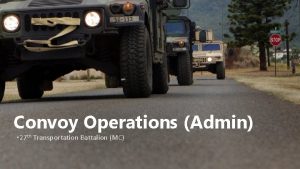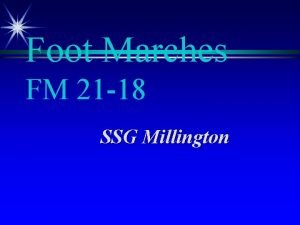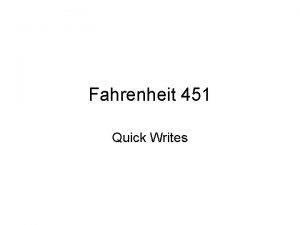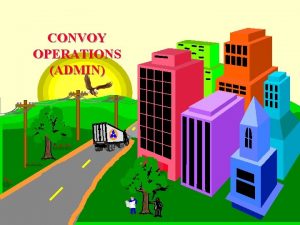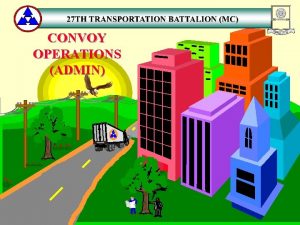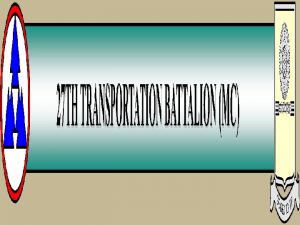Motor Marches and Convoy Ops 1 Motor Marches










- Slides: 10

Motor Marches and Convoy Ops 1

Motor Marches and Convoy Ops TRAINING OBJECTIVES • Proper Speed and Gaps • Vehicle Failures • Vehicle Halts • Convoy Security • NATO Convoy Flags and Signs 2

Motor Marches and Convoy Ops Proper Speed and Gaps The road, weather, and amount of space needed between vehicles to allow for stopping without rear-end collisions and for letting faster-moving vehicles pull into the column after passing, determine the proper speed and gap. Of all the space around the vehicle, the area ahead of the vehicle (the space the vehicle operator is driving into) is most important. A vehicle operator needs space ahead in case he/she must suddenly stop. According to accident reports, trucks and buses most often run into the vehicle in front of them. The most frequent cause is following too closely. If the vehicle ahead is smaller, it can probably stop faster. If following too closely, this may cause an accident as you will not have time to react. • • Determine how much space to keep in front of you How much space are you keeping Maintain proper place in the convoy Judging distances 3

Motor Marches and Convoy Ops Vehicle Failure If the vehicle fails while driving in a convoy, remember these basic rules: • Signal a stop and pull off the road. • Signal vehicles behind to proceed. • Correct the trouble if possible and fall back in the column at one of the breaks (halts). If the vehicle operator or a mechanic left with the vehicle operator cannot repair the trouble, wait for the trail officer and tell them of the difficulties. They will make the necessary arrangements. Vehicle Halts A convoy halt is made for personal convenience, checking the vehicle’s operational status, checking load security, and refueling (if necessary). Make the at-halt checks at each halt. Be sure to keep off the road, if possible, while checking the vehicle. If a vehicle operator must halt on the road, their designated assistant vehicle operator should act as a guard to warn other traffic. Each vehicle operator should accomplish specific duties while at the halt. These duties are determined by the convoy commander prior to start of convoy. Convoy Security Convoys are inviting targets for an enemy force. Convoys cannot always depend on military police support or added firepower. To provide more firepower for a convoy, units may employ a hardened gun truck to: • Provide a mobile firing platform. • Help counter enemy attacks. • Increase survivability of the convoy. 4

Motor Marches and Convoy Ops NATO Convoy Flags Mark each march unit of a convoy with flags that are 12 inches high and 18 inches long. The lead vehicle has a blue flag and the rear vehicle, a green flag. Mount the flags on the left front of the lead and trail vehicles, respectively. The flags should not interfere with the vehicle operator’s vision or with any functional component of the vehicle. The convoy commander and march unit commander’s vehicle must have a white and black flag on the left front bumper. The lead vehicle (pacesetter) in each element of the convoy must have on its front a sign with 4 -inch black letters on a yellow background reading CONVOY FOLLOWS. The last vehicle of each convoy element will have on the rear a sign (same black on yellow as above) reading CONVOY AHEAD. Convoy ahead signs are not placed on maintenance or medical vehicles unless that vehicle’s purpose is to represent the end of the convoy. 5

Motor Marches and Convoy Ops 6

Motor Marches and Convoy Ops Recovery is retrieving or freeing immobile, inoperative, or abandoned material from its current position and returning it to operation or to a maintenance site for repair. These actions are usually limited to towing, lifting and winching. Towing is typically limited to the nearest Unit Maintenance Collection Point. Recovery consists of: • Self-Recovery • Like-Recovery • Dedicated-Recovery AVOIDING THE NEED FOR RECOVERY • Choose your route carefully, avoid the 4 X 4 syndrome • Stay off severe slopes • Don’t try to exceed your vehicle limits • Ensure you select the proper gear and or transfer engaged • Do your PMCS, check drive train daily 7

Motor Marches and Convoy Ops Self Recovery Self recovery is done when your vehicle is equipped with a winch and you are able to pull your vehicle out of whatever position it is stuck in without the help from another vehicle Like Recovery Basic principle is to use a like vehicle to assist you in recovering your vehicle. Utilize tow cables or a tow bar. Follow the -10 operators manual. Dedicated Recovery Only used when self- or like-recovery attempts fail or safety considerations warrant. You will need to send a request to your unit for a dedicated asset to come recover you. Follow your unit SOP for requesting assistance. Once the request is sent you need to prepare site for recovery. Maintain security and monitor your radio. 8

Motor Marches and Convoy Ops • R Recon the area (pull/lift/winch from what position) • E Estimate the resistance • C Calculate the ratio (how much effort you will need) • O Obtain the resistance (total effort needed) • V Verify the resistance (check yourself) • E Erect your rigging • R Recheck your rigging • Y You are ready 9

Motor Marches and Convoy Ops CONCLUSION The responsibilities of a military vehicle operator include keeping the vehicle in a safe operating condition. The operator must also maintain the vehicle’s mechanical efficiency. Armored vehicles require increased-interval maintenance due to the intense wear on the suspension, steering, and braking systems. These components of the vehicle may prematurely fail unless more frequently checked by the operator. Ensure mission requirements provide time and opportunity to the inspect vehicles at an increased rate. 10
 Convoy mc number
Convoy mc number Bentuk generativity diantaranya adalah
Bentuk generativity diantaranya adalah David olère arrival of a convoy
David olère arrival of a convoy Bumper doc convoy
Bumper doc convoy Ssg foot
Ssg foot Symbols in fahrenheit 451
Symbols in fahrenheit 451 He who joyfully marches to music in rank
He who joyfully marches to music in rank Impératif présent
Impératif présent Pmmp - portail marocain des marches publics
Pmmp - portail marocain des marches publics Pmmp - portail marocain des marches publics
Pmmp - portail marocain des marches publics Soumission électronique marchés publics maroc
Soumission électronique marchés publics maroc
